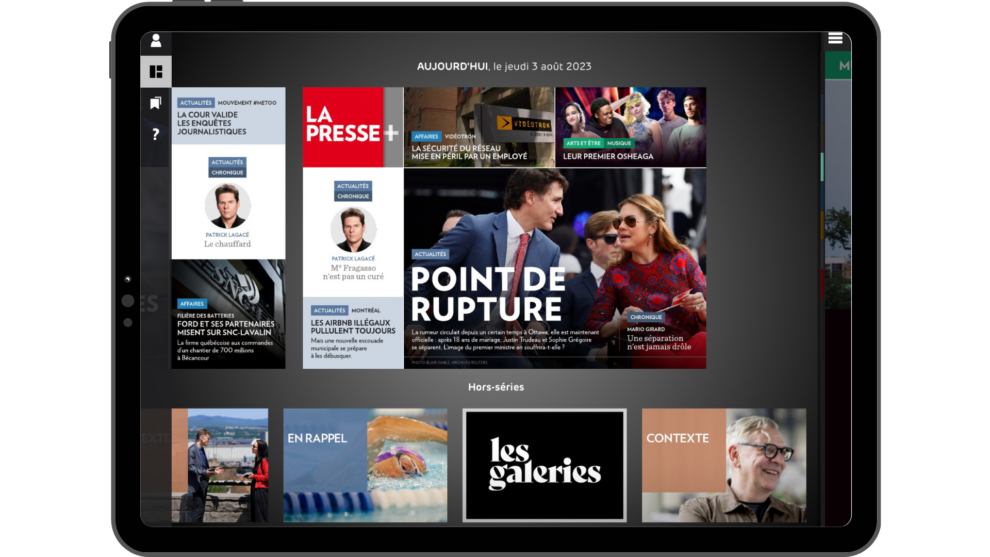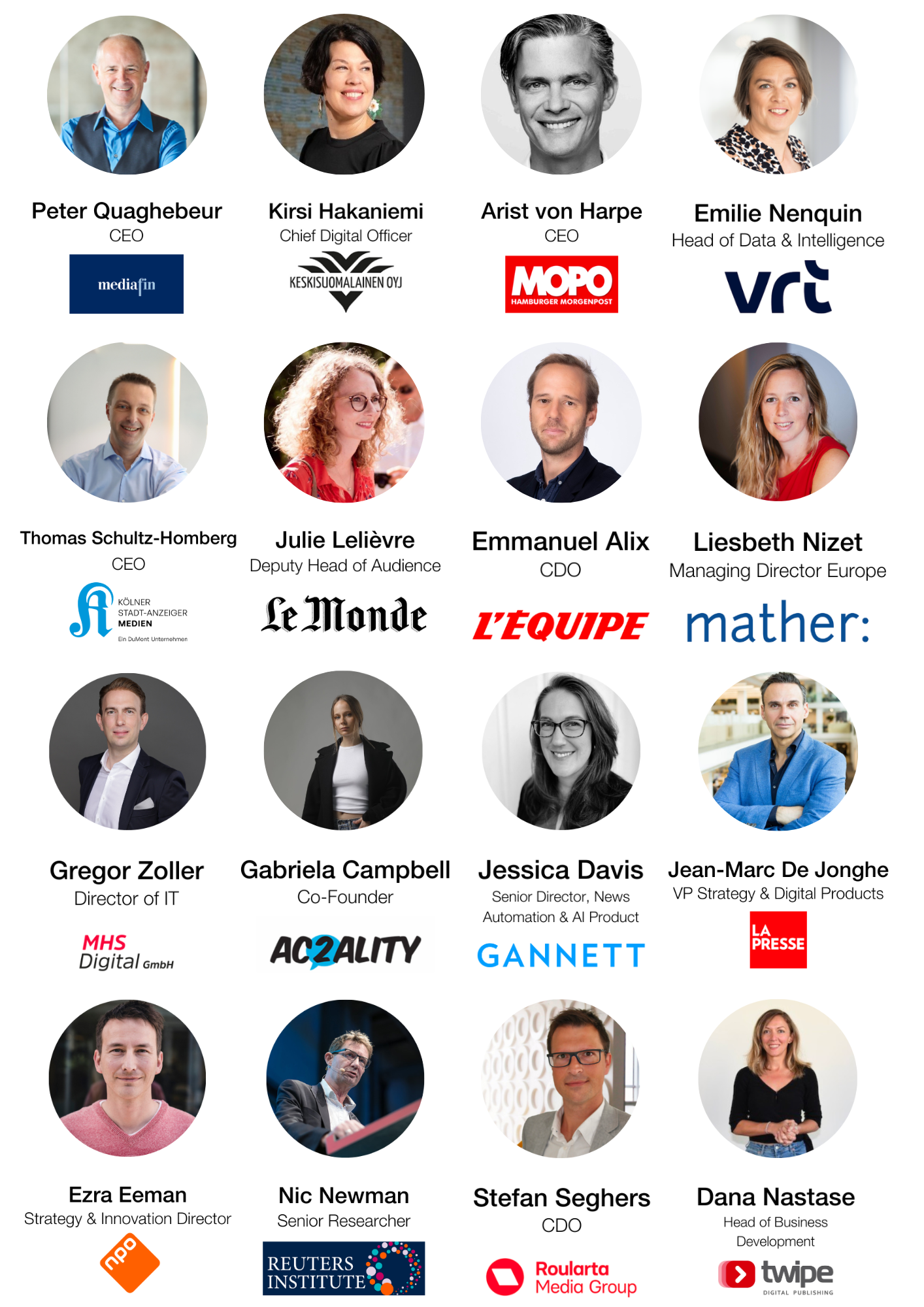
Continuing the Future of News blog series, we interviewed Jean-Marc De Jonghe, the Vice-President of Strategy and Digital Products from La Presse. We dived into questions about the organisation at La Presse and their approaches in the news industry, and most importantly what De Jonghe thinks of the future of news.
La Presse is a French-language news medium in Canada whose content is distributed on several platforms, including a digital edition for tablets and a mobile application and the web. La Presse is known for its distinctive, rich and diversified coverage of news and current events. The recipient of numerous awards for the quality of its content and its design, La Presse is also known for its in-depth series and special reports, as well as for the large amount of space it devotes to discussion and debate. La Presse+, the free-subscription digital tablet edition, fully leverages the multi-functional capabilities of apps to deliver the most comprehensive news and information experience ever from Québec’s largest newsroom.
What are the offerings of La Presse, and the different products that your audience can engage with?
There are currently 3 main products:
Website
Their website is viewed as the gateway to the rest La Presse’s product portfolio. The website content is curated to provide a diverse range of topics, catering to a broad audience with interests in local, national, and international news, as well as in-depth coverage of various subjects. The articles are crafted with a focus on accuracy, credibility, and journalistic integrity, reflecting the website’s commitment to delivering reliable and up-to-date information.
La Presse+
The flagship product designed for tablets. It is interactive and intuitive, combining the best of newspapers, magazines, the web and video for an enriching experience. Every morning from 5:30 a.m., you can find all the news simply by swiping the screens from right to left or by using the menu that takes you where you want it. Thanks to the Live panel, you will get real-time news throughout the day. The application also allows you to find previous editions and special editions of La Presse.

La Presse mobile app
They have also created a general app that is aimed more at the younger generations from millennials onwards, appealing to them with a ‘feed’ interface that is common across social media platforms.
The mobile app also includes a ‘La sélection’ module, with top stories selected by editors in a number of different categories including ‘Essential stories of the week’ and ‘Positive Stories’. The app is setup to provide finishability to readers, with each article telling you how long it takes to read and how many articles are left in the selection.

La Presse’s dedication to innovation is evident in its seamless integration of modern digital technologies and its willingness to adapt to the ever-changing landscape of online journalism. As a result, they remain a trusted source of news, offering readers a valuable and insightful window into the world’s events and stories.
La Presse has a mixed business model of memberships, subsidies and advertising. Could you briefly explain how that works?
All of La Presse’s products are free to use with no subscriptions. Simply download and it is ready to use, though new users must register with their email address beforehand. There is however an option to donate money to support La Presse’s newsroom, which helps them to sustain efficiency. Donations can be performed in 3 different ways:
- Unique (one-time);
- Monthly;
- Annually.
What are the key technologies that have been driving growth at La Presse in the past years?
According to De Jonghe, it isn’t the technology that makes the difference, even though they have a solid foundation of it. Rather it’s more about catering to users’ needs in terms of digital experience, and working towards achieving this.
What technology is crucial for business growth in the next 3 – 5 years?
De Jonghe reiterates the fact that it’s never about having the best technology. The focus should always be maintained on the users and creating the best user experience possible. After creating a vision for what the best user experience looks like, technology selection comes into play. This process helps to select which technologies are relevant to achieve the desired experience, and eliminates the others. Especially in the digital landscape where there is a plethora of different technologies, it is essential to implement a sorting system, to use only the ones that matches your specific vision.
La Presse had all their data in the cloud since 2018, and is one of the first ones to do this in the industry. This certainly helped them to become more agile as a company, and indeed more resilient against industry challenges, using a not-so-far back example of enduring through the Covid-19 pandemic.
But due to the amount of competition in the United States where their base of operation is mainly situated, it is not enough to just have great user experience. It is crucial to also create meaningful yet simple experiences. Even if the content is serious, it doesn’t stop La Presse from including animations and having an aesthetically pleasing interface.
Do you think Artificial Intelligence can help with achieving the desired user experience? What role do you think it plays within the industry?
According to De Jonghe, Artificial Intelligence certainly helps, but the key point is that it must help with creating a more meaningful experience for the end users.
News consumption is an ever-evolving process; what do you think is important when it comes to user retention and user acquisition?
La Presse keeps in mind that audiences are never too distinctive. Users may want a combination of print and digital editions of the news. Part of La Presse’s strategy is to constantly evaluate their understanding of the users, and continually adapt their product to offer everyone a taste of what a better user experience can look like.
Another strategy La Presse uses is tapping into the ‘fear-of-missing-out’ mentality, and building a habit-forming ritual with them, to offer a product that empowers them to do more than just scanning the news headline. As always, the goal is to create a meaningful and interesting product specifically targeted towards what the users are looking for, and to be where they are, which helps to generate enough interest for users to come back to their platform.
You oversaw the development of LaPresse+ and the shift of the digital team to an Agile methodology. What do you think is important in finding digital success in this rapidly changing digital landscape?
Focus, humility, and curiosity. Continuing the theme of putting users at the centre of every decision, it is imperative to only focus on building the best experience for your users, and not get distracted by wanting to build everything all at once.
In addition, having humility allows for the realisation that the “user is not you”. It is uncommon for the average user to have “12 news apps on their phone”. To understand how users consume the news clearly isn’t a straightforward task due to the rapid changes in behaviours and news consumption. De Jonghe pointed out that “habits are changing very fast in comparison to 10 years ago”, using the phenomenon of the transition from office, to work-from-home due to the Covid-19 pandemic.
Which brings us to the final point, curiosity. De Jonghe believes that without constant innovation, any digital product becomes inapt in less than 2 years. Therefore an agile methodology and a continuous learning needs to be an essential part of any organisation infrastructure. Keep experimenting and trying out different approaches is thus an ongoing process in the journey of creating the best user experience.
Users on average spend approximately 31 minutes per day on news apps – Think with Google
How important do you think finite formats are for the future of news?
De Jonghe stated that it is very important, however in La Presse there is a tension between creating a great storytelling experience, and creating app portability of that created experience. App portability means having the ability to ‘move your apps from the cloud back to on-premise or to an entirely different cloud provider’.
What De Jonghe meant by this is that to create portability, the product needs to meet the user’s expectations of what portability is. This means having universal product features that most users are familiar with, meaning that La Presse’s digital products will have less characteristics. This in turn diminishes the meticulously curated storytelling experience.
What is the biggest challenge for La Presse in the next 5-10 years?
To continue being humble and to also constantly reinvent themselves. To keep testing and “building small experiences to experiment and see where the market is”. And most importantly to not to be distracted by every trend that pops up and risk the chance of “losing the momentum of building something meaningful”.
De Jonghe quoted the acclaimed investor Warren Buffett on his 5/25 rule – to ruthlessly prioritise the most valued goals. This rule states that people or companies should focus solely on fully committing to those 5 goals, to effectively achieve them as they are the most important ones. Relating this back to the news industry, there are a myriad of different opportunities, tools, and trends surfacing every day. It is key to strive for the goals that are only relevant to the desired user experience, and not just for what is best for the newsroom nor the business. De Jonghe believes that by doing this, it will help your product stay relevant for years to come.
💡 Jean-Marc De Jonghe, together with many other news leaders will join this year’s Digital Growth Summit to share La Presse’s story on 26th September in Brussels – tickets are still available here.
Discover our speakers

